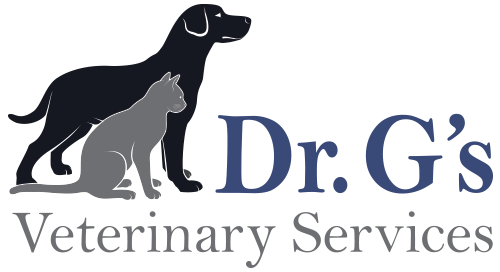Our Blog & Pet Health Topics
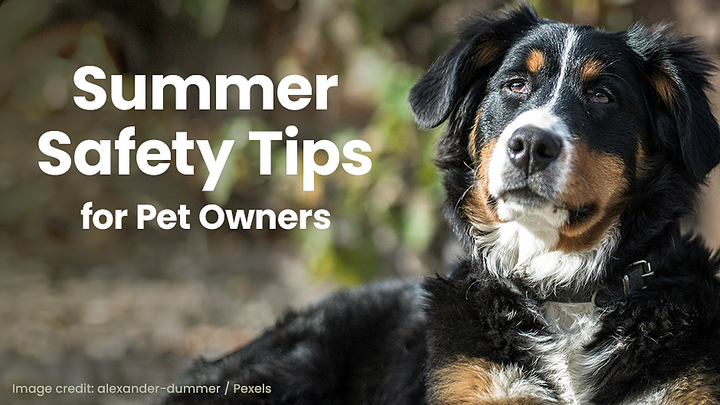
Summer Safety Tips for Pet Owners
Summer is a time for fun, relaxation, and outdoor activities. However, while we enjoy the warm weather, we need to take extra precautions to ensure our pets stay safe and healthy. Read on for valuable tips on keeping your pets safe during the summer months, addressing critical aspects such as hydration, anxiety from loud noises, increased activity levels, and encounters with wildlife.
Hydration: The Key to Summer Safety
One of the most important aspects of pet care during the summer is ensuring your pets stay hydrated. Dehydration can lead to severe health issues, and it’s particularly common during the hot summer months.
Signs of Dehydration
- Dry gums and nose
- Loss of skin elasticity
- Panting
- Lethargy
Hydration Tips
- Constant Supply of Fresh Water: Ensure your pets always have access to clean, fresh water. Consider placing multiple water bowls around your home and yard.
- Portable Water Bottles: If you’re taking your pet out for a walk or to the park, carry a portable water bottle designed for pets.
- Hydrating Treats: Offer hydrating treats such as ice cubes made from low-sodium broth or watermelon, which is safe for dogs in moderation.
- Avoid Excessive Exercise: Limit physical activity during the hottest parts of the day to prevent overheating and dehydration.
Managing Anxiety from Loud Noises
Summer often brings thunderstorms and fireworks, both of which can cause significant anxiety in pets. This anxiety can lead to destructive behavior, attempts to escape, and even physical health issues.
Identifying Anxiety Symptoms
- Trembling or shaking
- Hiding or seeking comfort
- Excessive barking or meowing
- Restlessness
Anxiety Relief Strategies
- Create a Safe Space: Designate a quiet, comfortable area in your home where your pet can retreat during loud events. This space should be filled with their favorite toys and bedding.
- Consider Calming Products: Products such as anxiety wraps, pheromone diffusers, or natural supplements can help reduce the stress your pets are experiencing.
- Behavioral Training: Gradual desensitization to loud noises through controlled exposure can help. Work with a professional trainer if needed.
- Consult With Us: In some cases, our veterinary team may prescribe anti-anxiety medication to help manage your pet’s stress.
Increased Activity and Social Gatherings
Summer barbecues and get-togethers mean more activity and potential hazards for pets. While it’s great to involve your pets in family fun, it’s important to keep their safety in mind.
Activity Safety Tips
- Supervise Playtime: Always keep an eye on your pets during gatherings to prevent them from eating harmful foods or getting into dangerous situations.
- Avoid Toxic Foods: Common barbecue foods like onions, garlic, chocolate, and alcohol are toxic to pets. Ensure these items are out of reach.
- Exercise Caution with Decorations: Party decorations, such as balloons and streamers, can be hazardous if ingested. Keep them away from curious pets.
- Practice Leash Safety: If your pet is not familiar with all the guests, keep them on a leash to prevent unexpected escapes or aggressive behavior. And, while we’re talking about unexpected escapes, now’s also a good time to make sure your pet’s microchip registration is up to date. No microchip? Schedule an appointment with us. Microchips give your pet the best chance of being reunited with you.
- When in Doubt, Give Your Pet a Safe Retreat: Some children simply are not aware of how to approach pets or play with them safely. This can cause stress for pets, and in worst case scenarios, lead to bites or other aggressive behavior. Give your pet a safe retreat where they can avoid the extra hustle and bustle.
Wildlife Encounters in Your Backyard
Summer also brings more wildlife into our yards, including raccoons, snakes, and other creatures. These animals can pose risks to your pets, so it’s essential to take measures to keep your backyard safe.
Wildlife Safety Tips
- Secure Trash Cans: Raccoons and other wildlife are attracted to food scraps. Use secure, animal-proof trash cans to keep them at bay.
- Remove Food Sources: Avoid leaving pet food outside, and clean up any fallen fruits from trees promptly.
- Inspect Your Yard: Regularly check your yard for signs of wildlife, such as burrows or nests, and take steps to deter them if found.
- Use Fencing: Install fencing around your yard to prevent larger wildlife from entering. Ensure that the fence is high enough and buried deep enough to prevent digging.
Conclusion
By following these summer safety tips, pet owners can ensure their furry friends remain healthy, happy, and safe throughout the season. From maintaining proper hydration and managing anxiety to supervising increased activity levels and safeguarding against wildlife, these measures will help keep your pets protected.
Stay informed, stay vigilant, and enjoy a wonderful summer with your beloved pets!
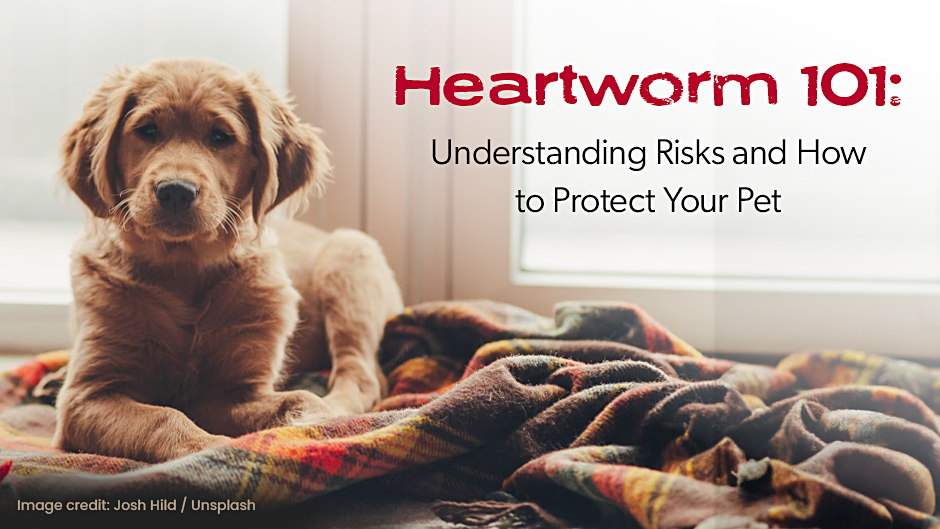
Heartworm 101: Understanding Risks and How to Protect Your Pet
Among the various health risks that pets face, heartworm disease stands out as a particularly insidious threat. This disease can have devastating effects on your pet, and yet, it is preventable. This article will delve into heartworm disease and stress the importance of proactive prevention.
Understanding Heartworm Disease
Heartworm disease is a serious and potentially life-threatening illness triggered by parasitic worms known as Dirofilaria immitis. These worms inhabit the heart, lungs, and connected blood vessels of afflicted pets. These parasites are transmitted through the bite of an infected mosquito, making the disease a concern for pet owners anywhere that mosquitos are present.
The progression of heartworm disease is slow but relentless. Infected pets may not show symptoms until the disease has advanced significantly, making early detection challenging. Symptoms include the following:
- Mild persistent cough
- Reluctance to exercise
- Fatigue after moderate activity
- Decreased appetite
- Weight loss
If left untreated, heartworm disease can lead to severe lung disease, heart failure, and other organ damage, ultimately proving fatal.
The Transmission Cycle Explained
The lifecycle of the heartworm begins when a mosquito feeds on an infected animal, ingesting microfilariae (baby worms) in the process. Within the mosquito, these microfilariae develop into infective larvae. When this infected mosquito then bites a healthy pet, the larvae are transmitted into the new host, where they mature into adult heartworms over a period of 6 months.
Understanding this transmission cycle underscores the importance of year-round preventive measures to protect your beloved pets from the grip of heartworm disease.
Prevention Over Treatment
Protection against heartworms is not just preferable—it’s essential. The treatment for heartworm disease is both costly and challenging, involving a long and potentially risky process to eliminate the adult worms from your pet’s body. Furthermore, the damage inflicted by the disease may have lasting effects on your pet’s health.
On the other hand, heartworm prevention is safe, effective, and far more economical. Preventive measures include monthly oral or topical medications, and in some cases, injectable products that can provide protection for extended periods. By incorporating heartworm prevention into your pet’s routine care, you’re not just safeguarding them against heartworms but also ensuring their overall health and longevity.
Trust Us With the Health of Your Pet
We understand the unique health history and needs of your pet. Our team is here to provide personalized recommendations on the most appropriate heartworm prevention protocol tailored to your pet’s unique risk factors and lifestyle. By purchasing heartworm prevention products directly from us, you can be assured of their authenticity, efficacy, and suitability for your pet.
Preventive care is the cornerstone of maintaining your pet’s health and well-being across all life stages. Don’t wait for heartworm disease to become a problem—proactive prevention is the key.
Call us to request an appointment today. Our dedicated team is ready to assist you in fortifying your pet’s defenses against heartworm disease, educating you on the best practices for preventive care, and supporting you every step of the way in your pet’s health journey. Together, we can ensure your pet leads a happy, healthy, and heartworm-free life.

Household Hazards: Understanding and Mitigating Pet Poisoning Risks
Owning a pet offers immeasurable joy, companionship, and love. However, it also comes with the responsibility of ensuring their safety and well-being. Many common items found in our homes could pose significant poisoning risks to our furry companions. By understanding these hazards and how to prevent them, we can create a safer environment for our pets.
Key Household Hazards for Pets
Chocolate
Widely known but often underestimated, chocolate contains theobromine, which is toxic to dogs and cats. Even small amounts can cause vomiting, diarrhea, and more severe symptoms. As you’re filling Easter baskets or baking holiday treats, be mindful to keep chocolate out of reach and clean up any spills immediately.
Houseplants
Many popular houseplants are poisonous to pets. For instance, lilies can cause kidney failure in cats, and sago palms can be lethal if ingested by pets. This time of year, in particular, brings an abundance of lilies, tulips, and daffodils, so be extra cautious.
Medications
While medications are meant to help us, they can be dangerous for pets. Keep all prescriptions and over-the-counter drugs securely locked away from curious paws if you’re entertaining guests for holiday festivities, store handbags, coats, and other items that may contain toxins out of reach, as well. Never give your pet any medication without consulting a veterinarian first.
Cleaning Products
Household cleaners, such as bleach, disinfectants, and laundry pods, can cause severe chemical burns and respiratory issues in pets if ingested or inhaled. Always place these items out of reach of pets, and thoroughly rinse any surfaces where they’ve been used.
Trash and Unattended Items
The trash can is a treasure trove of potential dangers—from coffee grounds to spoiled leftovers to food packaging. Keep it securely closed and don’t leave any items unattended, as pets may be tempted to chew or ingest them.
Practical Prevention Tips
View Your Home Through Your Pet’s Eyes
Get down to their level and identify potential risks—place chocolate in unreachable places, ensure houseplants are out of reach, and keep medications locked away.
Secure Trash and Unattended Items
Ensure trash is inaccessible and routinely check bags, backpacks, and purses for any items that could harm your pet. Make a routine of placing these items out of reach when you come home.
Recognizing Symptoms of Pet Poisoning
Be vigilant for signs of distress in your pets, such as vomiting, diarrhea, lethargy, and excessive drooling. Early recognition can make a significant difference in outcomes.
Emergency Actions for Pet Owners
In the unfortunate event that you suspect your pet has ingested a poisonous substance, prompt action is critical. Immediately call your veterinarian or a pet poison control center. Time is of the essence, and their guidance could save your pet’s life.
Maintaining a pet-friendly environment requires diligence and an ongoing commitment to their safety. By proactively identifying hazards and implementing preventive measures, we can vastly reduce the risk of pet poisoning. Remember, our pets rely on us for their well-being—it’s our duty to protect them.
For further information on pet care and emergency resources, please do not hesitate to reach out to us.
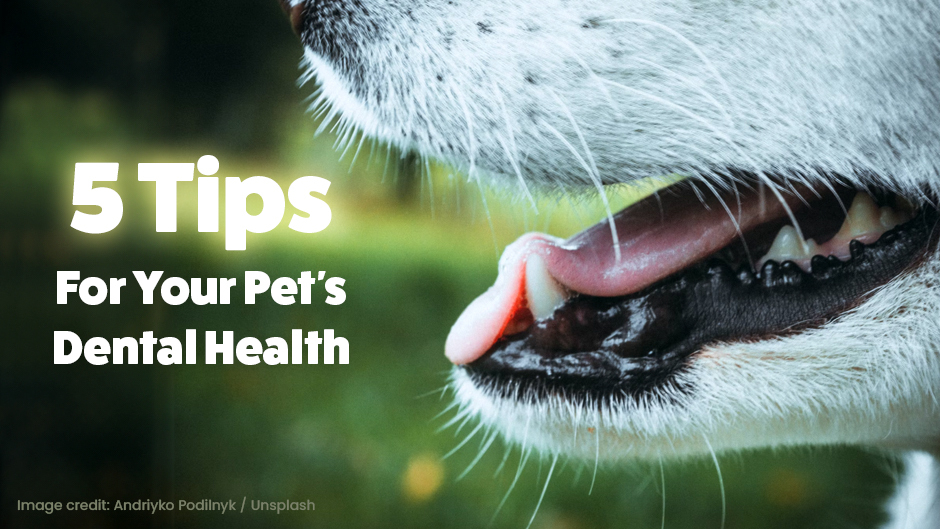
5 Tips for Your Pet’s Dental Health
We all wish for our furry friends to live happy, healthy lives by our side. But often overlooked in pet care is a critical area that affects their overall well-being: dental health. Just like us, pets’ teeth need regular attention to prevent discomfort, disease, and systemic health issues. In this article, we’ll provide you with five essential tips to give your pet the sparkling, healthy smile they deserve!
The Benefits of a Healthy Smile
The twinkle in your pet’s eye is often matched by the joy in their smile. But beneath the surface, dental issues in pets can lead to pain, infection, and even heart or kidney problems. Being proactive with dental health can add years of wiggly, wet-nosed companionship to your pet’s life.
Tip 1: Regular Brushing
Dental brushing is the gold standard for pet oral health. With a little patience and the right method, you can make it an enjoyable part of your pet’s routine.
- Technique: Start slow with just a finger to get them used to the sensation. Gradually introduce a pet toothbrush and toothpaste formulated for pets. Never use human toothpaste to brush your pet’s teeth.
- Frequency: Aim for a daily brushing session. Consistency is key to keeping teeth and gums in top condition.
- Tools: Soft-bristled brushes and enzymatic toothpaste made for pets are gentle options designed for delicate pet mouths.
Tip 2: Appropriate Dental Diet
What your pet eats significantly impacts their dental health. Choose their meals wisely to support strong teeth and gums.
- Dry Kibble: The crunch of kibble can be a good mild abrasive, helping to clean teeth as your pet chews.
- Special Formulas: Some pet foods are engineered with dental health in mind, designed to decrease plaque and tartar buildup. We can help provide suggestions which take into consideration your pet’s age, lifestyle and overall health needs.
Tip 3: Chew Toys and Dental Treats
Chew toys and specially designed treats can be your pet’s best buddies in the battle against plaque.
- Chew Toys: Tough rubber, nylon, or rawhide chews can provide a satisfying and tooth-scraping experience for your pet.
- Treats: Dental treats can be a tasty, effective way to reduce plaque and tartar.
Ask us about the safest options for chews and treats that will provide benefits to your pet’s dental health.
Tip 4: Professional Dental Cleanings
Despite your best efforts, some dental issues require professional intervention.
- Importance: Regular visits to a veterinary dentist ensure that both routine cleaning and potential issues are addressed promptly.
- Frequency: Your vet is the best person to advise on how often your pet needs professional dental care. Typically we recommend professional dental cleanings one time per year.
- Anesthesia: While it can be a concern, modern techniques have made it very safe for sedating your pet for thorough dental cleaning. This allows us to identify dental disease below the gumline and develop a comprehensive treatment plan specific to your pet.
Tip 5: Monitoring Oral Health
Knowing the signs of dental issues can help you catch and treat problems early.
- Visual Checks: Regularly inspect your pet’s teeth and gums. Look for signs of bleeding, bad breath, or swelling.
- Behavioral Clues: Changes in eating habits or excessive drooling can signal dental discomfort, prompting a closer examination.
- Regular Veterinary Visits: Your vet visit isn’t complete without a quick oral examination. Don’t hesitate to raise any dental concerns you might have, and reach out to us to schedule an appointment.
Your Pet’s Smile is Your Mission
Your pet’s dental care is a partnership between you and your trusted veterinarian. Implementing these key tips will not only enhance your pet’s quality of life but also save you from potential veterinary expenses in the future. Remember, their well-being is in your hands, from choosing the right dental diet to detecting early signs of trouble. So, scoop up that toothbrush and let’s give your pet the megawatt smile they were born to flaunt!
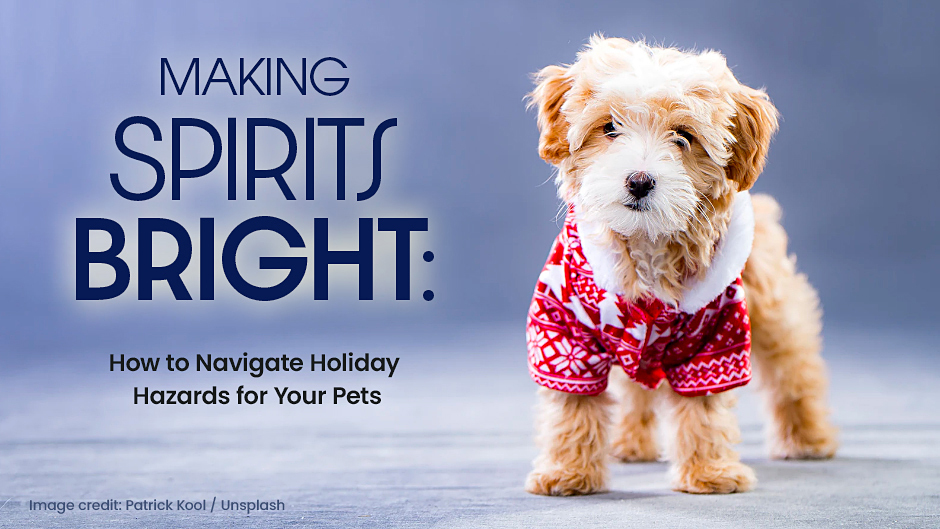
Making Spirits Bright: How to Navigate Holiday Hazards for Your Pets
The holiday season is a time of joy and celebration, but it can also bring unexpected challenges for pet owners. As a veterinary team, we’ve seen our fair share of holiday-related pet emergencies, from tinsel ingestion to Christmas tree accidents. But with a little bit of preparation and foresight, you can help keep your pet friends safe and healthy this holiday season. In this blog, we’ll share some common holiday hazards for pets and offer practical tips for avoiding them.
Deck the Halls with Care: Managing Your Holiday Decorations
The dazzling lights, sparkling tinsel, and shiny ornaments that fill our homes during the holidays can be as captivating for our pets as they are for us. But some holiday decorations can also pose serious health risks to our furry friends. For example, tinsel, garland, and ribbon can easily cause intestinal blockages if ingested by pets. Likewise, breakable ornaments can cause cuts to your pet’s mouth or paws, and chewed electrical cords can cause burns or even electrocution.
To keep your pets safe during the holidays, make sure to secure all decorations, such as tinsel, garland, and ribbon, to prevent your pet from ingesting them. If you have a curious pet that likes to play with decorations, consider using safer decorations such as felt or paper products.
Oh, Christmas Tree: Managing Your Tree and Lights
Setting up the Christmas tree is a beloved tradition in many homes, but it also requires vigilance when it comes to pet safety. Pine needles, if ingested, can cause stomach issues for pets, and the water that keeps the tree fresh can also be toxic to your pet. Additionally, broken ornaments or lights can pose an electrical and choking hazard to pets.
To prevent these hazards, make sure to sweep up any pine needles that drop from your tree regularly. Also, consider covering the tree stand with a skirt or some other barrier to keep your pets away from the water. Finally, place ornaments higher up on the tree, and consider using shatterproof ornaments to help reduce the risk of accidental breakage.
If necessary, you may even want to block off the tree from pet access.
The Gift of Health: Protecting Your Pets from Parasites
In the hustle and bustle of the holiday season, it can be easy to forget important preventative care for your pets, such as parasite protection. Fleas, ticks, heartworms, and intestinal parasites don’t take a holiday, and can make your pet miserable if not properly treated or prevented.
To keep your pet healthy, make sure to provide them with monthly parasite prevention according to your veterinarian’s recommendations. This can include oral or topical medications for flea and tick control and heartworm preventatives. By staying on top of parasite prevention, you can help ensure your pet stays happy and healthy all year long.
Share the Love: Spending Quality Time with Your Pet During the Holidays
Finally, one of the best ways to keep your pet safe and happy during the holidays is by spending quality time with them. Pets thrive on attention and companionship, and the holidays can be a perfect opportunity to show your pet how much you care. From going on walks to cuddling up on the couch for a movie marathon, there are plenty of ways to share the holiday spirit with your furry friend.
The holidays can be a joyful time for pets and their owners, but they can also pose unexpected hazards if not properly managed. By taking precautions such as securing decorations, managing your Christmas tree, staying on top of parasite prevention, and spending quality time with your pet, you can help ensure a safe and happy holiday season for everyone in your household. We wish you and your pets a joyous and safe holiday season!
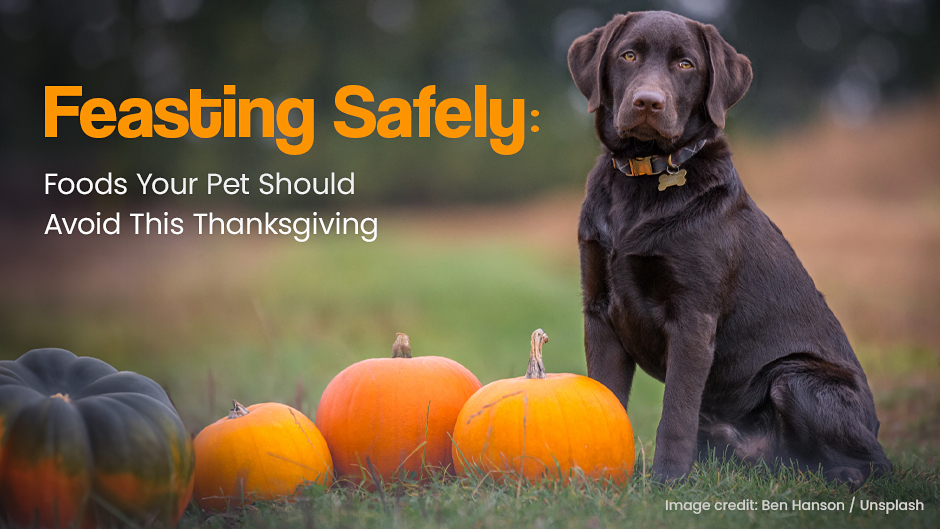
Feasting Safely: Foods Your Pet Should Avoid This Thanksgiving
As Thanksgiving approaches, we all prepare to indulge in festive treats and a hearty Thanksgiving meal. But as pet owners, we must remember that our furry friends should not indulge in the same way. This Thanksgiving, we have compiled a list of foods your pet should avoid. Read on to learn how to keep your pets safe while you enjoy a delicious feast.
Onions and Garlic
Onions and garlic, whether they are cooked or raw, are toxic to pets. Make sure to keep onions and garlic out of reach of your pets, and never feed food to pets that may contain these ingredients, such as stuffing or other side dishes. Symptoms of ingestion include abdominal pain, vomiting, diarrhea, and lethargy. If you suspect your pet has consumed any food containing onions or garlic, seek veterinary care immediately.
Grapes and Raisins
Grapes and raisins are common in Thanksgiving dishes, such as stuffing or salads. However, consumption can lead to kidney failure, which can be fatal. Even small amounts of grapes or raisins can cause significant harm to your pet’s well-being. If your pet eats these items or foods containing them, seek veterinary care immediately.
Alcohol
Alcohol is present in many Thanksgiving drinks, such as beer, wine, and cocktails. However, pets should never consume alcohol, as they cannot metabolize it as humans do. Consumption can lead to vomiting, diarrhea, difficulty breathing, and even coma or death in severe cases. Keep all alcoholic beverages out of reach of your pets, and ensure that your guests do the same.
Turkey Bones & Gravy
While turkey is a staple in most Thanksgiving meals, pet owners should be careful about what part of the turkey their pets consume. Turkey bones are a hazardous choking and intestinal obstruction hazard for pets. Turkey skin and gravy are high in fat content and can lead to gastrointestinal upset such as vomiting and diarrhea. Keep your pets away from the kitchen and food if possible, and always dispose of turkey bones safely away from your pets.
Hidden Hazard – Medications
With extra people visiting your house for Thanksgiving, be aware that curious pets may discover medications in handbags or coat pockets. Commonly used over-the-counter painkillers can have disastrous consequences for your furry friends. If you are hosting guests this holiday, be sure to remind them to keep all medications secured and avoid leaving bags or pockets accessible to your pets. Better yet, consider putting your pet into a quiet room away from the commotion and potential food hazards.
This Thanksgiving, ensure that your pets are not harmed by any food or drink that may cross their path. By being mindful and keeping these forbidden foods in mind, your pets will remain safe and happy throughout the festive season. If you notice any symptoms of ingestion or injury to your pets, seek veterinary care immediately. Remember, extra caution goes a long way in creating a happy and healthy holiday season. We hope you and your beloved pets have a wonderful Thanksgiving holiday!
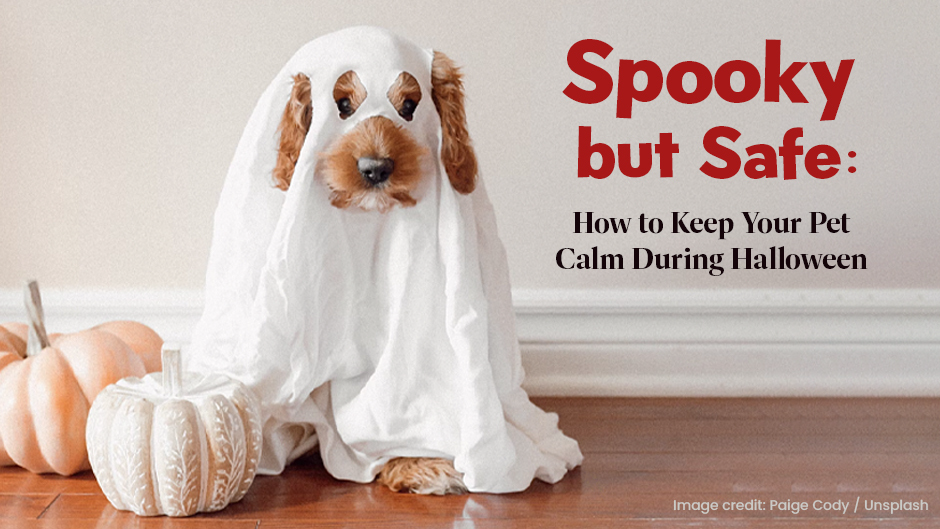
Spooky but Safe: How to Keep Your Pet Calm During Halloween
Halloween is one of the most awaited events for kids and adults. The streets are filled with people wearing creative costumes, decorations are everywhere you look, and sweet treats and the scent of pumpkin spice fill the air. While it is a festive occasion, this can also be a time of stress and anxiety for our pets. Here are some tips on how to keep your pet calm during Halloween:
Halloween is fun for people but can be stressful for pets
Halloween is a time to celebrate with friends and family and have fun with spooky costumes, which is why most people look forward to this holiday. However, for pets, it can be a terrifying experience. Often, they get scared by the sudden appearance of strangers, loud noises, and unfamiliar smells, which can lead to anxiety or even aggression. It’s essential to keep a close eye on your pet when the festivities are happening outside, and even inside your home.
Costumes can be scary and uncomfortable for pets
While dressing up in costumes can be fun, your pets might not be on board with the idea. Most pets are not used to wearing costumes, and the sensory experience can be overwhelming for them. Noisy, and tight clothes can make them uncomfortable, anxious, or even frightened. Moreover, costumes that involve masks or hats can limit their vision and hearing, further adding to their fear.
Beyond costumes⸺other dangers for pets
While costumes are a significant part of Halloween, there are other dangers you need to be aware of when it comes to your pets. Here are some of the most significant threats you need to watch out for:
- Candy/Chocolate: Halloween treats are not safe for pets. Chocolate, especially dark chocolate, can be toxic to dogs. Candy may contain xylitol, which is toxic to dogs and can cause severe consequences such as seizures, vomiting, and even death.
- Candles: Candles and pumpkins make for excellent Halloween decorations, but they can be hazardous to your pets. Your pet may accidentally knock over the candle which could lead to injury or in the worst-case scenario, a fire.
- Excitement at the door: Trick-or-treaters knocking at the door can be a happy moment for people, but it might cause stress for your pets. The constant knocking, ringing, or noise can induce fear or anxiety in pets.
- Extra Noise: The loud noises from doorbells or people laughing and cheering outside the door can also be frightening for pets. These things may also cause behavioral issues like anxiety, fear, or stress in our pets.
How to create a quiet space for your pet
It’s essential to create a comfortable and safe space for your pet during Halloween. You can create a little corner for them in your home, with their bed, toys, and blanket. It should be a quiet room away from the front entrance. Also, consider adding white noise or calming music to soothe their nerves.
Halloween can be stressful for pets, and it’s essential to take action to ensure their safety. Be aware of the potential dangers that could harm your furry friend and take steps to keep them out of harm’s way. Creating a quiet space for them and avoiding costumes will make a significant difference in their stress levels. With these tips, you will have a safe and happy Halloween with your furry loved one.
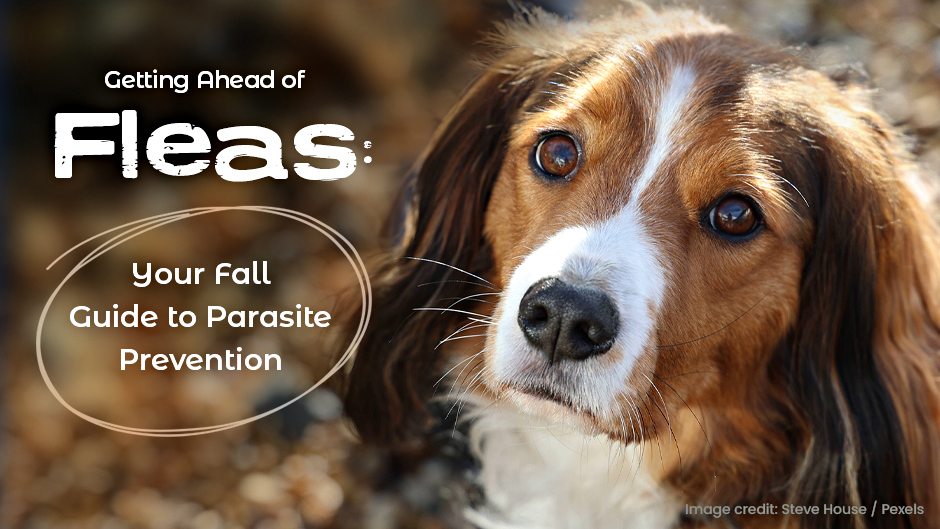
Getting Ahead of Fleas: Your Fall Guide to Parasite Prevention
As pet owners, we can attest that flea infestation can not only be annoying but also extremely dangerous to our pets. Fleas can cause severe skin irritation, and anemia, and even transmit deadly diseases. As we approach the fall season, it’s essential to be proactive in preventing fleas before they become a problem. In this article, we will discuss the flea life cycle, the dangers of fleas infesting your pet, signs to look out for, the benefits of flea prevention, and why you should purchase flea prevention medication from us, your trusted veterinarian.
Flea Life Cycle:
Fleas have a life cycle that consists of four stages; egg, larvae, pupae, and adult. The eggs can be found on your pet’s bedding, furniture, and carpet. Next, they hatch into larvae, which then feed on organic debris. After a week or two, they spin cocoons, where they become pupae and develop into adult fleas within five to fourteen days. Once the adult fleas emerge from their cocoons, they start feeding and reproducing.
Dangers of Fleas Infesting Your Pet:
Fleas can cause tremendous discomfort to your pet. Pets will continuously scratch and bite themselves, leading to skin irritation, hair loss, anemia, and infection. Fleas can also transmit diseases such as cat scratch fever and tapeworm infections to both pets and humans.
Identifying Signs of Fleas in Your Pet:
One of the primary signs that your pet may have fleas is excessive itching, particularly around their neck, hindquarters, and tail. Hair loss and red or inflamed skin are also signs of flea infestation. In severe cases, you may even see fleas jumping on your pet, but often the “flea dirt” (feces) is the best sign. Flea dirt looks like small black specks that can be found in your pet’s fur, and when wet, they turn a reddish-brown color as they contain digested blood.
How Flea Prevention Helps:
Flea prevention is the best way to protect your pet from flea infestation. Preventing them from gaining a foothold is much easier than treating a full-blown infestation. Consistent use of flea medication throughout the year is critical in maintaining your pet’s health and protecting your home from flea infestations.
Why Purchase Flea Prevention Medication from Us, Your Veterinarian:
With so many flea medication products available, it can be challenging to decide which one is best for your pet. However, we, as veterinarians, have the experience and knowledge of the different flea medication products, how they work, and which one is safest for your pet’s specific needs, especially given their health history. Additionally, we only sell products that are manufacturer-guaranteed to ensure quality. By purchasing from us, you can rest assured that you get authentic and properly stored medication for your pet.
As the fall season approaches, it’s essential to protect your pet from flea infestation. Fleas can cause immense discomfort to your pets and transmit dangerous diseases to both them and you. Identifying signs of flea infestation, understanding the flea life cycle, and investing in flea prevention medication is crucial in maintaining your pet’s health and preventing flea infestations. At our veterinary clinic, we only offer safe, effective flea prevention medication and can help you decide which one is best for your furry friend. We invite you to schedule an appointment with us and get ahead of fleas this fall season.
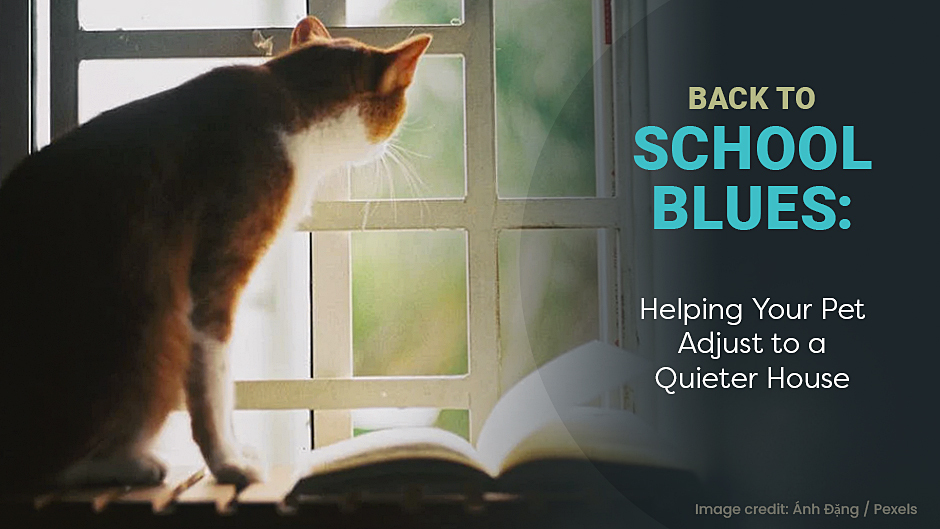
Back to School Blues: Helping Your Pet Adjust to a Quieter House
Back to school season is an exciting time for kids, but for pets, it can be the source of anxiety and stress. After a summer filled with playtime, cuddles, and attention, the sudden decrease in activity can have a profound impact on our pets. It’s common for pets to experience separation anxiety when their families head back to work and school, and it’s important for pet owners to recognize the signs and take steps to help their pets adjust. In this blog post, we will discuss some strategies to help your pets ease into a quieter home.
Identifying Signs of Separation Anxiety
Separation anxiety can manifest in many ways, such as excessive barking, digging, chewing, pacing, or inappropriate elimination. Sometimes, the signs are more subtle, and pets can become lethargic, withdrawn, or refuse to eat. If your pet shows signs of separation anxiety, it’s important to recognize the problem and address it promptly.
Why it’s Important not to Scold Your Dog or Cat
Although it’s tempting to scold your pet for may at first appear as “misbehaving”, remember that punishment only worsens anxiety and can cause more stress. Instead, focus on positive reinforcement and reward your pet with treats, toys, or praise for good behavior. Make sure your pet has access to comforting items such as their favorite blanket or toy, and work toward building a strong bond between you and your pet.
Pre-Plan for When School Starts
To help ease the transition, start preparing your pet before school starts. Begin to introduce your new routine by slowly changing your pet’s schedule, so that when your new schedule takes effect the transition will not be as abrupt. Make sure to incorporate a consistent daily routine that includes playtime, walks, and plenty of attention.
Solutions to Help After School Has Begun
Creating Structure for Your Pet
Establishing a regular routine is key when it comes to helping our pets adjust to spending more time alone. Create an environment that is calming and consistent, making sure to give your pet plenty of exercise, playtime, potty breaks, and cuddle sessions throughout the day.
Consider Doggy Daycare
Doggy Daycare can provide socialization and playtime with other dogs, which can be an excellent way to ease anxiety and boredom. If your pet isn’t comfortable in large groups, try a pet sitter who can come to your home to give your pet attention and company.
Increase Mental Stimulation Activities
Boredom is a major contributor to anxiety in pets, so try to incorporate mental stimulation activities into your pet’s daily routine. For example, hide treats around the house, give your pet puzzle feeders, or play games like fetch or tug of war. This can help keep your pet’s mind occupied and reduce feelings of stress and loneliness.
Increase Walking Frequency
Walks provide not only physical exercise but also mental stimulation for pets. If possible, try to take your pet on longer walks before and after work/school to help burn off energy and reduce restlessness. Additionally, walking provides an opportunity for pets to explore their surroundings and expend mental energy. (And, they’ll love spending the extra time with you!)
Make Arrivals and Departures Less Emotional
Since pets pick up on their owners’ emotions, try to make departures and arrivals as low-key as possible. Avoid lengthy goodbyes, and greet your pet calmly when you come home. This can help reduce anxiety and make transitions less stressful.
Book a Visit to See Us
Finally, if your pet is struggling with separation anxiety, please book a visit to see us. Our veterinary team can provide expert advice and recommend appropriate treatment options
Separation anxiety in pets can be a challenging issue to manage, but by recognizing the signs and taking proactive steps, pet owners can help their pet family members adjust to a quieter home. Remember, your pet relies on you for comfort and security, so be patient and offer plenty of love and support. If you’re concerned about your pet’s behavior, book a visit to see us, and we’ll be happy to help.
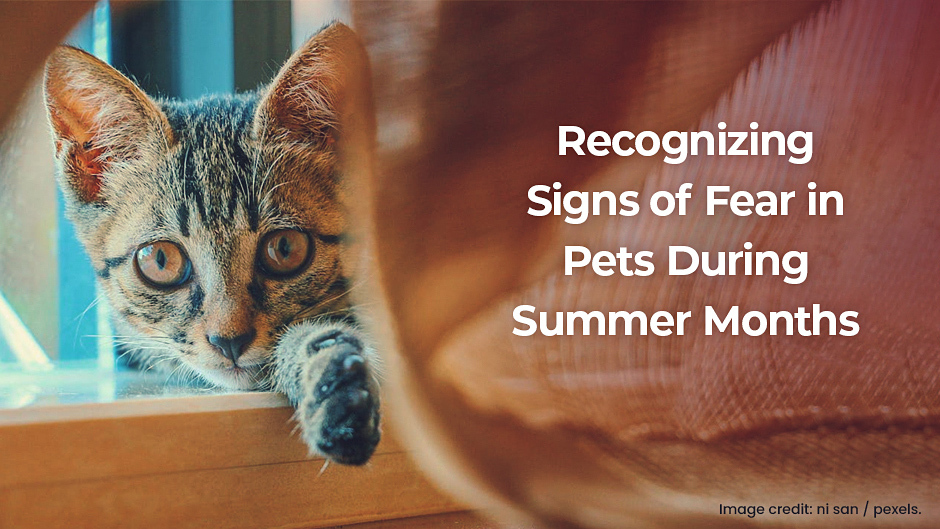
Recognizing Signs of Fear in Pets During Summer Months
As pet owners, it’s crucial to prioritize the mental and physical health of our beloved companions. One of the most common causes of stress in pets is summer thunderstorms and fireworks. During these events, pets exhibit various behaviors that indicate fear and stress. When experiencing a thunderstorm or fireworks, pets may pant excessively, bark or howl, tremble, hide, or even become destructive. These behaviors can be alarming and cause stress to both the pet and the owner. So what can you do to help alleviate your furry friend’s stress during these situations?
Provide a Comfortable and Safe Space
It’s essential to create a comfortable and safe space for your pet during a thunderstorm or fireworks. Keep your pet indoors and away from windows. Consider creating a cozy space with their favorite toy, blanket, or bed in an interior room, preferably where they feel comfortable.
Play Calming Music
Just like humans, animals can be sensitive to noise. Providing calming music can help create a quiet, peaceful environment for your pet to help them relax, in addition to reducing the sounds of the booms outside.
Consider Products That Help Calm Pets
Various products are available in the market that can help calm pets during thunderstorms or fireworks. There are specific articles of clothing, such as calming wraps and shirts, which apply gentle pressure and offer a calming effect during stressful situations. Calming sprays, diffusers, and treats can help reduce anxiety and stress in pets. Make sure that the products you are using are pet-safe and specifically created for pets. Our veterinary team can provide guidance on items that may help in your pet’s specific situation.
Anticipate the “Booms”
Once you have a calm area set up for your pet, don’t forget to take time to prepare your pet in advance for the upcoming “booms”. Pay close attention to weather alerts and relocate your pet to their calming space BEFORE the noise begins. Similarly, be aware of local events which may be displaying fireworks over the next several weeks.
By making time spent in this calming space a positive one, rather than a stressful one, you can help your pet cope better in the future. Provide a special treat or toy when they’re there to make it an enjoyable experience.
Seek Help from a Veterinarian
In severe cases, pet parents may need to seek help from a veterinarian to reduce their pet’s stress levels. Vets can prescribe medications that help alleviate anxiety and provide advice on other methods that can help comfort and soothe pets during storms or fireworks.
Being proactive can go a long way in helping your pet feel safe and comfortable during the summer months. Keeping a close eye on their behaviors, providing a safe space, playing calming music, trying products that help calm pets, and seeking help if needed are all important steps to ensure your pet’s well-being.
Make sure to prioritize your pet’s mental health and well-being by taking the necessary steps to alleviate their stress during thunderstorms and fireworks. If you notice any signs of severe stress, don’t hesitate to seek help from our veterinary team.
